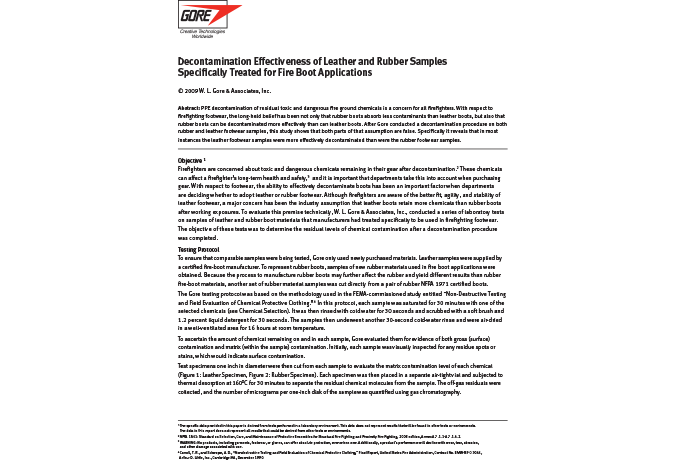
Decontamination effectiveness of leather and rubber Oct 2011
Download PDF
Optimum levels of comfort and protection in footwear
Containing a reliable barrier against pathogens found in blood and body fluids.
Prevents penetration of NFPA commonly encountered fireground chemicals. The fabric properties remain intact even after contamination.
Durably waterproof to keep the feet dry and comfortable on the job.
Highly breathable, which is crucial for allowing sweat vapor to escape during strenuous activities.
Optimized shoe constructions enable lighter weight and increase mobility and agility.
GORE-TEX CROSSTECH® fire boots are wet flexed 5X the NFPA requirement to ensure product performance while in use.
Boots with GORE-TEX CROSSTECH® laminates have been proven to withstand high heat exposure and still deliver excellent breathability and reliable waterproofness.
*For Firefighters and Tech Rescue Boots only.
Footwear with GORE-TEX CROSSTECH® moisture barriers leads the industry in providing durable protection and highly breathable comfort for the feet. With the addition of GORE-TEX CROSSTECH® technology, the footwear now also provides a crucial barrier against the penetration of viruses and bacteria found in blood and body fluids as well as against the penetration of common chemicals. No other manufacturer requires the level of testing Gore does to ensure the footwear performs over and above the standards. We begin by ensuring that every boot liner is durably waterproof, then expose the finished boot to a battery of additional tests to ensure it’s ready for the challenge. This means professionals working in emergency situations no longer need to compromise on either comfort or protection: This footwear offers optimum levels of both.
Firefighters, law enforcement and technical rescue responders face several common challenges while working, including foul weather, common chemical exposure and the risk of coming into contact with pathogens found in blood and body fluids.
GORE-TEX CROSSTECH® laminates provide protection against these threats, while also offering unparalleled comfort in the form of breathability. This enables feet to stay dry, less prone to injury. and reduce heat stress that can lead to fatigue. When professionals are running up and down stairs, climbing ladders and navigating through unpredictable terrains while responding to emergencies, their footwear needs to weigh as little as possible so they can perform effectively. Leather boots made with GORE-TEX CROSSTECH® footwear laminate are lightweight, form-fitting, and more comfortable - helping wearers to stay energized for longer. With these benefits combined with the right fit, optimum traction, and flexible movement, boots made with GORE-TEX CROSSTECH® footwear laminate work with the wearer and allows them to focus on the task ahead.
The technology consists of a durable outer layer of flame-resistant material and the GORE-TEX CROSSTECH® laminate.
The 3-layer laminate consists of a highly abrasion resistant textile lining, the GORE-TEX CROSSTECH® membrane and a protective knit. The 4-layer laminate comes with an additional thermal insulation layer.
The use of a flame-resistant upper material makes the boots flame resistant.
The GORE-TEX CROSSTECH® membrane has been engineered to resist penetration of viruses and bacteria found in blood and body fluids. Barrier properties remain intact even after heat exposure and contamination.
Providing industry-leading comfort and durable protection from the everyday challenges firefighters face, including pathogens found in blood and body fluids.
Improved fit, comfort, and long-lasting protection allows for greater agility when responding to an emergency.
Reliable law enforcement footwear that keeps feet comfortable and protected in all kinds of conditions.
Protection from exposure to blood-borne and viral pathogens, garments with GORE-TEX CROSSTECH® laminates allow medical professionals to focus on the job.
OEKO-TEX® Standard 100, Class II
NFPA 1971 - Protective Ensembles for Structural Fire Fighting and Proximity Fire Fighting
NFPA 1951 - Protective Ensembles for Technical Rescue Incidents
NFPA 1999 – Standard on protective clothing and ensembles for Emergency Medical Operations
We'd love to help you with your inquiry about our products, partnerships, or anything else you would like to know about GORE-TEX® Professional Fabrics.
Your boots play an important role in your protection and safety, and for years, there has been thought that leather boots provided better footing. Now, thanks to a joint research study by Auburn University and the University of Mississippi there is support for this thinking.
In the study, professional firefighters participated in fire simulation activities wearing rubber boots and then leather boots, separated by a rest period. The results of the study indicated that the firefighters were four times more likely to have a hazardous slip when wearing rubber boots than when wearing leather boots.
In cases where departments may prefer leather boots for improved comfort and agility, budget constraints may result in settling for rubber boots with an initial cost between $100 and $200 less than leather. However, the cost of potential injury may not be considered in these decisions.
Based on a recent NFPA report of line-of-duty injuries, more than 14,700 firefighters (out of 1.1 million) were injured because of falls, slips, or jumps in 2011, and the National Safety Council has determined that the average cost for a slip/fall injury was $41,393.
Bringing these figures closer to home...in a department with 1,000 firefighters*, the above reports' data would suggest that approximately 12 members would have sustained a slip/fall injury in 2011, for a total cost of almost $500,000. Additionally, based on the data from the universities' research study, wearing leather boots instead of rubber can potentially lower a fire department's rate of slip/fall injury by 4 times – translating to saving your department $375,000, or $375 per firefighter.
*Individual department size and statistics may vary.

Gore tested the long-standing theory that rubber decontaminates better than leather. The results were surprising: leather samples were found to retain less residual chemical contamination than rubber samples following decontamination procedures. The tests were conducted using a FEMA testing protocol, which focused on chemicals that firefighters are likely to encounter in the field, including carbon disulfide (CS2), tetrachloroethylene, isooctane (gasoline), acrylonitrile, dimethyl formamide (DMF), and diethyl amine.
Read the Fire Engineering article about the decontamination study.
 Decontamination effectiveness of leather and rubber_FINAL_Oct2011.pdf
Download PDF
Heat and Flame
Fire & Safety
GORE-TEX CROSSTECH®
GORE-TEX CROSSTECH Footwear
Decontamination effectiveness of leather and rubber_FINAL_Oct2011.pdf
Download PDF
Heat and Flame
Fire & Safety
GORE-TEX CROSSTECH®
GORE-TEX CROSSTECH Footwear
Residents of some states have the right to opt-out of the “sharing” or “selling” of their personal information. Gore does not "sell" the personal information of website users. Gore may "share" the personal information of website users, as standard advertising practice meant to offer you a more personalized service.
If you want to opt-out from Gore “sharing” your personal information, click on Opt-Out of Sharing to turn off the targeting cookies that we share with our advertising partners in order to provide you with personalized information. Disabling sharing will stop the use of cookies to targeted advertising but you may still see generic Gore ads.
Please note that your exercising of the rights outlined will have no adverse effect on the price and quality of our goods or services.
Opt-Out of SharingYou Have Successfully Opted Out of the Sharing of Your Personal Information
Please note that if you clear your cookies and then use another device or browser, etc. your opt-out status is not transferred to the new device or browser.

